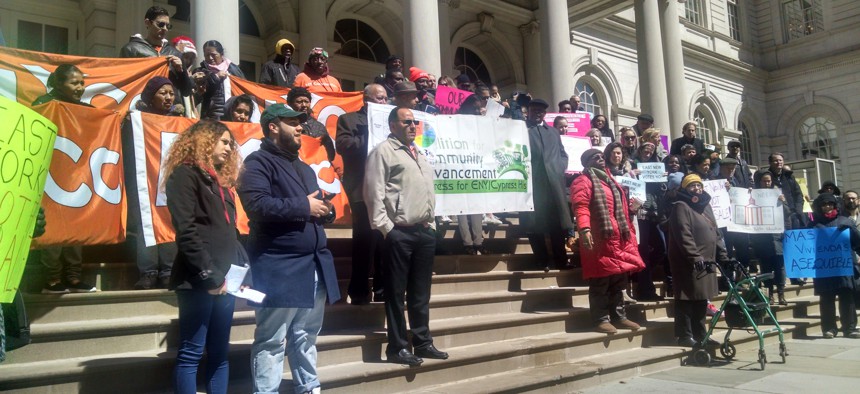Ana Aguirre prompted dozens standing on the steps of New York City Hall Sunday to denounce the mayor’s rezoning plan for East New York, yelling, “What do we say to this plan?”
“No!” the crowd of nearly 100 responded. Several of them emphasized their opposition by waving signs reading, “Don’t Build on Me” and “East New York for East New Yorkers.”
“We have to remind our City Council members, we vote for you,” Aguirre, executive director of United Community Centers in East New York, continued. “Now it’s time for you to vote for us. They have to vote no.”
With just weeks to go before the New York City Council votes on a plan to authorize larger residential developments in East New York, the local representative, City Councilman Rafael Espinal Jr., has come under pressure. First, New York Communities for Change organized a demonstration and highlighted its report contending Espinal would “fail” his constituents if a rezoning plan passed without guaranteeing half of new apartments are affordable to current, low-income residents. Then on Sunday, Aguirre and a group she helps lead – the Coalition for Community Advancement: Progress for East New York/Cypress Hills – urged the lawmaker and his colleagues to reject the plan.
The Council traditionally votes however the local lawmaker does when considering land use decisions. Espinal represents most of the area in question. But it also includes a portion of City Councilwoman Inez Barron’s district, and she has spoken against the proposal. The Council is likely to take up the rezoning at its April 20 meeting, according to people familiar with the proposal.
Amid the tension, Espinal expressed frustration that Mayor Bill de Blasio’s administration had not begun negotiating with him in earnest. The councilman said his chief goals are to include anti-displacement policies and a job creation plan and to ensure more units are within reach of the lower-income constituents he represents. Espinal's office said the councilman could not support the current plan without changes.
But as of Friday, he said talks with de Blasio officials were proceeding in a constructive manner. His office had a Monday meeting scheduled with the administration. He and City Council Speaker Melissa Mark-Viverito are then slated to meet with the Coalition for Community Advancement on Tuesday.
“The administration and I have been having really good, positive talks over the past two days, and we’re looking to sit down within the next week to hash out the plan,” Espinal said Friday. “There are individuals out there who are still very concerned with the plan, and they are fighting for deeper affordability. I hear them. And that’s going to be my goal.”
De Blasio spokesman Austin Finan said the administration believed the discussions were progressing.
“The city is currently having very productive conversations with Council Member Espinal on the East New York rezoning plan,” Finan said in a statement issued Sunday. “Since the beginning of the East New York planning process, we have been and remain committed to ensuring that the final proposal to be voted on by the City Council meets the affordable housing and community infrastructure needs of East New York residents.”
Meanwhile, the Coalition for Community Advancement is picking apart the mayor’s plan, which would authorize larger buildings in parts of East New York but require that a portion of the residential projects be permanently affordable. The zoning framework de Blasio’s team is using will not guarantee homes for those earning less than 40 percent of the metro area median income – or $31,080 for a family of three. More than one-third of East New York’s residents earn less than 30 percent of the area median income.
The de Blasio administration has committed to using subsidies and other mechanisms to ensure half of new homes ushered in by the rezoning are available to existing residents. But so far, housing officials have identified just 1,200 such units, which has the coalition concerned that developers may shrug off subsidies and build enough market-rate towers to drive up local rents and displace locals.
As a remedy, the coalition is promoting an alternative rezoning plan that would include commitments to build more apartments for lower-income families, to implement anti-displacement policies and to exclude some manufacturing sites as well as Arlington Village from the area up for rezoning.
If rezoned, Arlington Village, a 300,000 square-foot parcel in East New York with two-story, rent-stabilized buildings, could incentivize the owner to push out about 220 current tenants and build taller, market-rate homes, the coalition contends. Maria Reyes, a long-time Arlington Village resident, said a new company bought the development for $30 million last year.
“We want to preserve the character of our buildings – 220 tenants that live there,” Reyes said. “We want our investors to think with their heads and not in their pockets. We want to be protected.”
At the rally on Sunday, state Sen. Martin Dilan, who represents East New York and Cypress Hills, and Assemblywoman Latrice Walker, who represents Ocean Hill and part of East New York, urged the city to rethink the current proposal, arguing that it could spur gentrification and displacement. The Black Institute founder Bertha Lewis also described the plan as emblematic of a discriminatory administration intent on redeveloping minority neighborhoods regardless of what residents think.
“This man is a gentrifier in progressive clothing; this man is a gentrifier in chief,” Lewis said of de Blasio. “We will stop this by any means necessary. So we’re not asking the City Council, we are demanding.”


